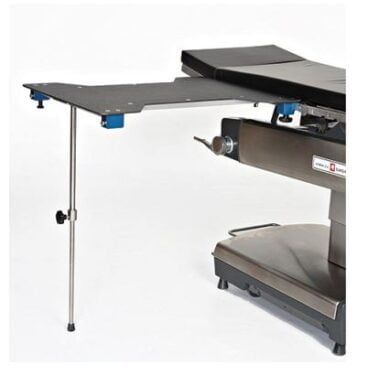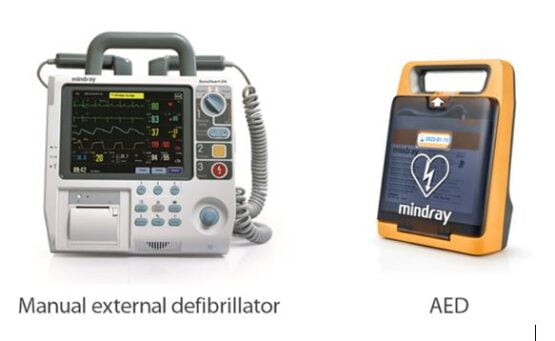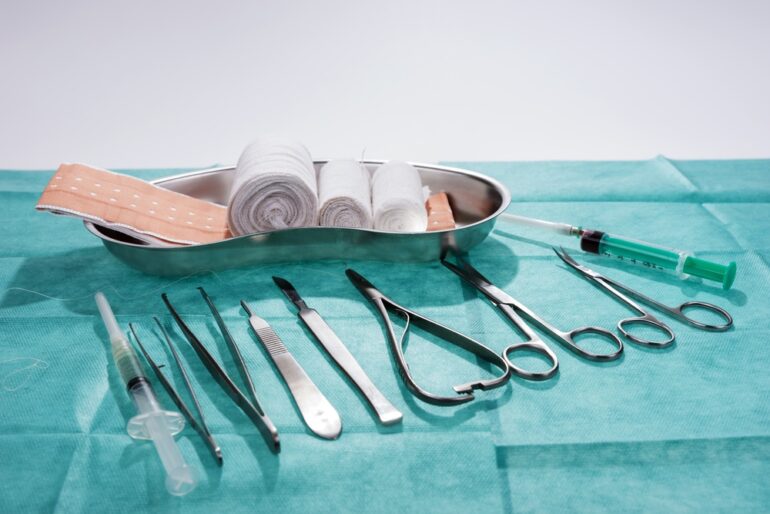Conducting surgery is not an easy task. It requires skill and years of practice but to get surgery right, those are not the only things needed. Along with these important factors, equipment used in the surgical rooms is also of prime importance to obtain the best results from the medical procedure. Let us take a look at the 10 most commonly used as well as highly important supplies and accessories of the operating room or the OR.
Following are the 10 Surgical Supplies and Accessories Every Operating Room Should Have

Surgical equipment in the operating room
1. Surgical Tables with Accessories
One of the basic needs for an OR to work is the presence of a surgical table. These tables vary based on the type of surgery intended to be performed such as general, orthopedic, neurological, etc. Accessories such as hoops, drain pans, screens, and positioners as well as side extensions are included with the surgical tables. Moreover, an arm and hand surgery table, as well as cushions and a headrest, also accompanies the main surgical table. In addition, these surgical tables can also be equipped with clamps that hold the IV sets, anesthesia screens as well as arm boards.

The surgical table along with an additional arm and hand table
2. Surgical and Examination Lights
Surgical and examination lights are a necessity within an operating room. From halogen lights to LED ones, these lights come in a variety of different options. Pure white lights are preferred as they enhance clarity during the procedures. These surgical lights can be ceiling-mounted, surgical headlights, or mobile surgical lights based on the need.

Ceiling-mounted operating room examination lights
3. Patient Transfer Devices
For the purpose of transferring a patient from one bed to another or from one room to another, patient transfer devices are must-haves. These include multiple devices such as patient lift slide transfer belts for lifting the patient single-handedly, transfer sheets, and transfer boards with or without rollers. Stretchers are also included in this category which provides a smoother transfer of patients.

Patient lift slide transfer belt
4. Disposables and Consumables
Disposables and consumables are the smaller but essential items that are used in an operating room on a daily basis. These include:
- Waterproofing pads
- Personal protective equipment, abbreviated as PPE, includes facemasks, face shields, surgical gloves, protective clothing, helmets, goggles, respirators, etc.
- Biohazard bags
- Tissue adhesives
- Surgical dressings
- Wound care supplies
- Surgical drapes
The use of these items reduces the chances of an infection transfer near to zero. In this way, contamination is reduced.

Some of the operating room disposables and consumables
5. Surgical Equipment Covers
With open surgeries, one of the major risks is contamination as the patient can be infected by the operating room equipment if it is not properly sterilized. To minimize the chances of sepsis, the latex-free surgical equipment covers come in handy. They come in the form of adjustable sheets made up of plastic and can fit on almost all kinds of OR items.

Surgical equipment cover
6. Anesthesia Screens
Anesthesia screens are employed while performing outpatient surgeries which are mostly minor and localized. These screens provide a separation between the patient and the surgeon who is working on the area to be operated on. This way, the patient cannot get a visual of what is going on during the operation which can be an overwhelming view for some patients.
7. Infection Control Equipment
Operating rooms are the places where microbial buildup is massive thus rendering the premises unhygienic for conducting an open surgery. These bacteria, viruses, and other microscopic entities can get transferred via surgical equipment to the patient where serious sepsis can occur. Sterilization equipment is one of the must-haves in an OR as there is a need to sterilize the surgical equipment prior to each surgery.

Infection control equipment
8. Defibrillators
Defibrillators, although not a necessity for every surgical procedure, must be kept within an operating room as a safe side. These devices are useful in case of an emergency situation if the patient’s cardiac rhythm gets disturbed during the surgery. They are portable devices that are easy to transfer with the patient while shifting beds or rooms. With their use, the need for CPR can also be eliminated in some cases.

Some defibrillators used in OR
9. HD Cameras for Surgeries
For some intricate surgeries of the organs or tissues located deeper into the body, it becomes difficult for the surgeons to visualize. At this point, HD surgical cameras are being employed these days which can be entered into the body along with smaller lights. The lights brighten up the tissues which are then viewed by the cameras. This facilitates the surgeon to easily conduct any type of surgery.
 |  |
Surgical cameras | |
10. Emergency Power Backups
Loss of power, while a surgical procedure is ongoing, can prove to be life-threatening for the patient. To manage this situation, if encountered, emergency power backups must be installed within the operating rooms. These will keep the lights working as well as the equipment working including oxygen supply machines until the power gets back.
Conclusion
While conducting a major or minor surgery, it is important to take note of the surgical items which are available in the operating room. Things such as stretchers, operating tables, lights as well as sterilization equipment, among others, are essentialities for performing open surgery. Hence, the stock of these items, along with their proper functionality, must be checked before starting an operation.

PhD Scholar (Pharmaceutics), MPhil (Pharmaceutics), Pharm D, B. Sc.
Uzma Zafar is a dedicated and highly motivated pharmaceutical professional currently pursuing her PhD in Pharmaceutics at the Punjab University College of Pharmacy, University of the Punjab. With a comprehensive academic and research background, Uzma has consistently excelled in her studies, securing first division throughout her educational journey.
Uzma’s passion for the pharmaceutical field is evident from her active engagement during her Doctor of Pharmacy (Pharm.D) program, where she not only mastered industrial techniques and clinical case studies but also delved into marketing strategies and management skills.
Throughout her career, Uzma has actively contributed to the pharmaceutical sciences, with specific research on suspension formulation and Hepatitis C risk factors and side effects. Additionally, Uzma has lent her expertise to review and fact-check articles for the Health Supply 770 blog, ensuring the accuracy and reliability of the information presented.
As she continues her PhD, expected to complete in 2025, Uzma is eager to contribute further to the field by combining her deep knowledge of pharmaceutics with real-world applications to meet global professional standards and challenges.








